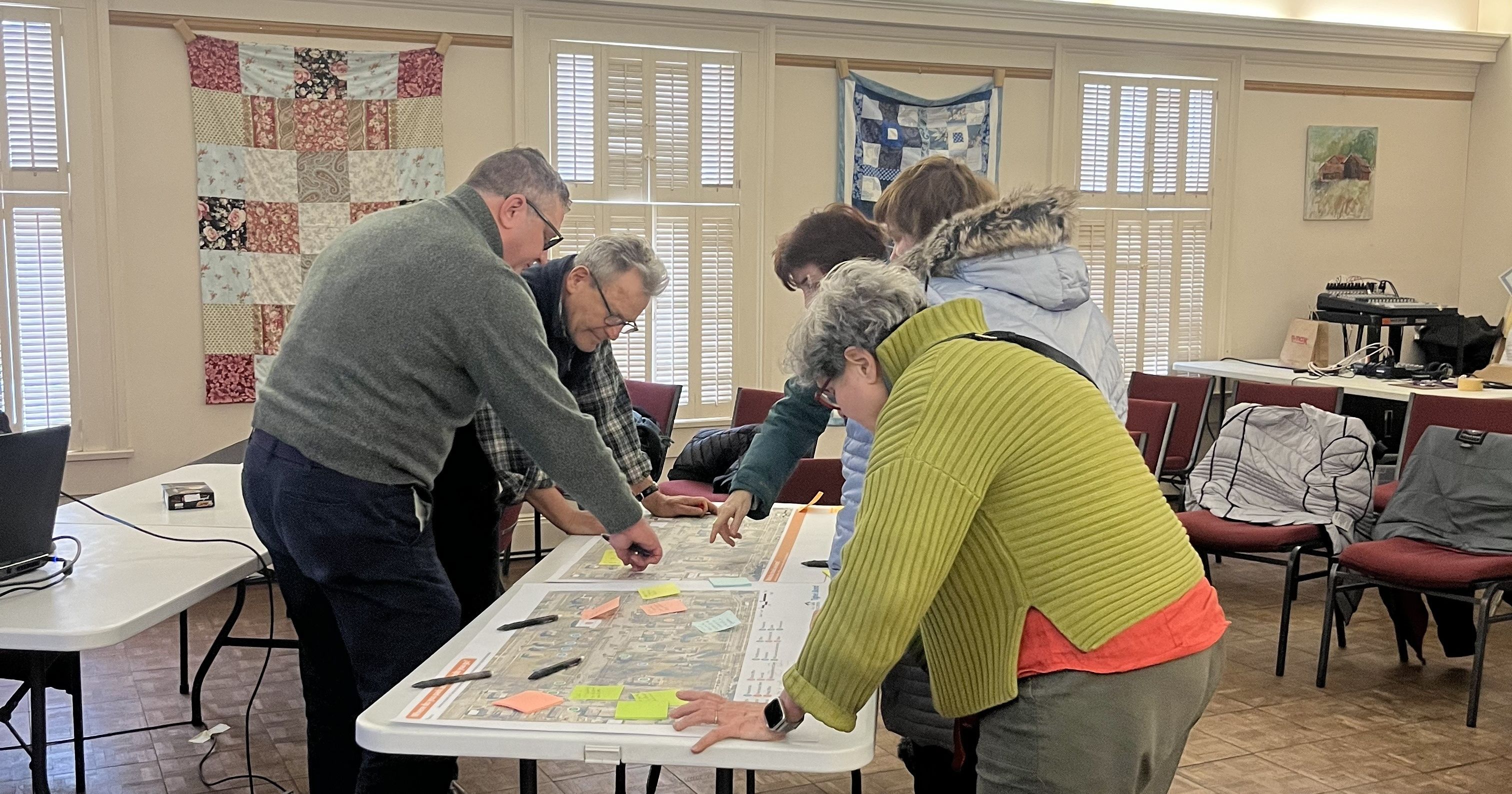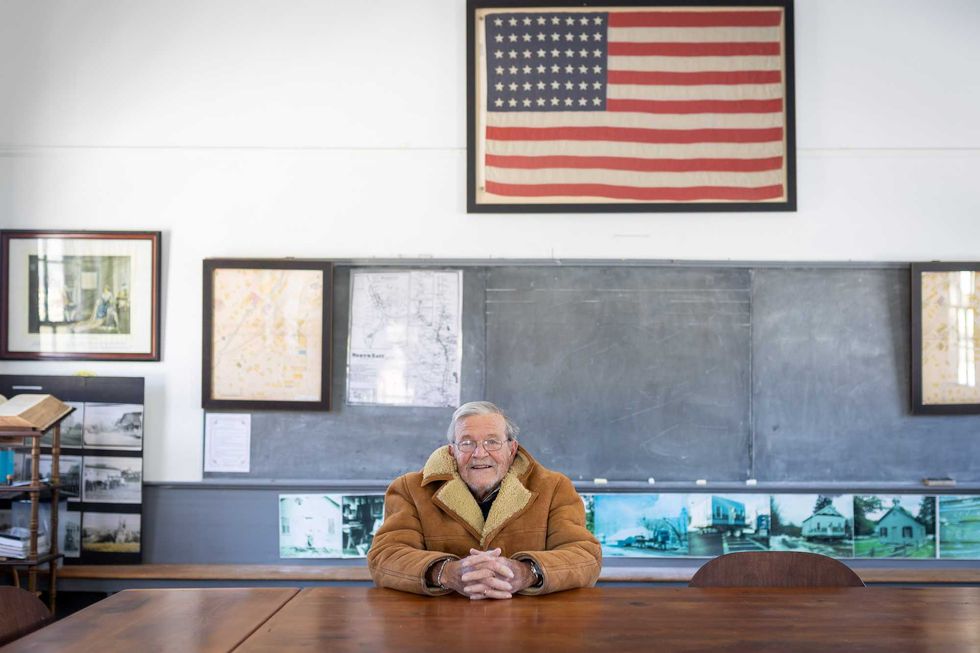Village trustees hear feedback on Century Blvd. redevelopment

Village Trustee Matt Hartzog showing members of the Millerton community the Tighe & Bond map of Century Boulevard.
Photo by Colleen Flynn

Village Trustee Matt Hartzog showing members of the Millerton community the Tighe & Bond map of Century Boulevard.
MILLERTON — On Saturday, Feb. 1, a public information meeting was held to discuss the “complete street” plan for Century Boulevard.
Village of Millerton trustees Matthew Hartzog and David Sherman have been involved with the preparation of forming the new look along Century Boulevard.
“Matt Hartzog and I have been involved in relative to those boards and work that we do to see what we can do with Century Boulevard,” said Sherman, “We realize that in order to proceed into the future, we really need to have a good plan that everyone, most everyone, likes.”
The Village of Millerton is working with Tighe & Bond for this project, an engineering, landscape architecture, planning and environmental science consultant company.
Brandee Nelson, Vice-President at Tighe & Bond, ran the meeting with a presentation including renderings of what the Boulevard could potentially look like with their plans, as well as taking advice from local residents.
“I myself am a civil engineer with a land use planning and development background, and we’re here today to start a conversation,” said Nelson, “We’re here to talk about the community’s vision for Century Boulevard.”
According to Sherman, the Village has received funding from the Berkshire Taconic Northeast Dutchess Fund and from Hudson River Valley Greenway in their community planning funds, which will go toward the cost of this street renovation.
“From the 2018 Millerton Pedestrian Plan, one of the future projects in that plan was to re-envision Century Boulevard and make it a complete street,” Nelson said. “A complete street is serving a variety of needs to the community. There’s pedestrian movement along that street. We know we have limited sidewalks out here, parking, trees, perhaps lighting, perhaps stormwater management, there could be a lot of different things in a complete street.”
Nelson noted the importance of parking on Century Boulevard and how this plan can help pedestrians get to the shops in the Village safely. She also said planners need to lay out a certain number of handicap accessibility spots, electric vehicle chargers and also provide a crosswalk in their “complete street.”
Century Boulevard’s width ranges from 70 feet to 93 feet, which surpasses the average street width of 50 feet, according to Nelson. Though the extra room allows more offerings to be installed, keeping up with that much pavement can be continually costly.
“We want to think, ‘Can we accommodate some green space there? How can we allocate this space in a way that is economical for operation and maintenance in the future?’” Nelson said. “Look how big that paved area is and that it doesn’t have any kind of organizational framework. There’s no striping. Not even a center line striping ... The day we were down here, people were kind of parked everywhere, and they were parked at different depths. We should think about how we can organize a little bit better.”
A concerned resident brought up an issue of tractor trailers going in and out of Harrington’s.
“That’s why it’s 90 [feet wide] there, to make that turn. When they come in, they sit there until they can back in,” the resident said. “There’s nobody to back them in and there’s a car behind them, they have to wait until someone comes out to help.”
After a handful of community members agreed with this worry, Nelson expressed an interest in reaching out to Harrington’s specifically to help in finding a solution.
“We are going to take the information that you’ve shared with us today and go back and develop two concept plans for the complete street,” Nelson said. “We will come back and hold a second meeting, and we are hoping to do that in early March time frame, where we will take more feedback from that.”
After the second public information meeting, they will turn the community’s ideas into a preferred plan to present to the Village board, which is planned for April. This will show the specific cost plans and the ballpark of the low and high cost production.
“We’re not talking about changing the street in the next two years,” said Nelson. “We’re probably about changing the street in the next five years, if we are successful in getting the grant funds.”
The meeting ended with a table exercise of residents and community members writing on maps of the street, stating how they use the area or what they would like to see in the future.
“Feel free to mark them up,” Nelson said. “I’m happy to take notes from anyone who’s got thoughts on how this road can be used better.”
Ralph Fedele sits at a desk in the historic Irondale Schoolhouse, which he led the effort to relocate to downtown Millerton.
MILLERTON — After serving for 12 years on the North East Town Board, Ralph Fedele says he has only one regret.
“I wish I could be called a ‘local,’” he joked with a warm, booming laugh.
Fedele moved to Millerton from New York City 37 years ago, in 1988, and has since worn many hats — volunteer, historian, advocate, elected official — yet he still doesn’t believe he’s earned that title.
“I’m a transplant,” he said matter of factly. “I’m from the city.”
Before settling in Millerton, Fedele spent 25 years working in merchandising at JCPenney.
His roots, however, trace back to Rhinebeck, where he grew up on a 97-acre farm and enjoyed what he describes as an idyllic childhood.
“It was marvelous,” he said, with a twinkle of nostalgia in his eyes. As a boy, he climbed apple trees, spent hours in the family barn’s hayloft, played with neighbors until sunset, and helped his Sicilian grandmother — his nonna — in the garden. Today, Fedele wears her ring. “Any time I’m a little depressed or I want to remember,” he said, “I can talk to her.”
Growing up with an Italian grandmother sparked a lifelong love of history and culture. That curiosity eventually took Fedele to Italy, where he visited the church in which his grandmother was baptized. “Because I love history so much, I wanted to know where my grandmother was from, so I traveled to her village in Sicily.”
Along the way, he uncovered another piece of family history. His great-grandfather, Giovanni Nicolini, was a noted Italian sculptor whose work still stands outside Palermo’s Teatro Massimo, the largest opera house in Italy. Fedele later made a pilgrimage there and photographed his ancestor’s name on the bronze plaque outside of the theater.

The Irondale Schoolhouse
Years after settling in Millerton full time, Fedele was driving north on Route 22 when he spotted an old, classic building and couldn’t stop thinking about it.
“It was in dire straits,” he recalled. “Right on the road, but beautiful. I remember thinking, ‘Wouldn’t that be a great building to move into the village?’”
That moment would eventually turn into Fedele’s lasting legacy.
He left his post at the North East Historical Society to found Friends of the Irondale Schoolhouse, leading an eight-year effort to “move, restore, and repurpose the building.”
Supervisor Chris Kennan said the project remains inseparable from Fedele’s name. “Every time I pass by the Schoolhouse, I think of Ralph,” Kennan said. “It was his vision and persistence that enabled this dream to become a reality.”
Fedele joked that people may have thought he was crazy during the lengthy restoration. “I was a tyrant,” he said with a laugh. “I really made sure that we were able to get it done.” The effort required coordination with the state, the county, village and town officials, and his newly assembled nonprofit board.
As a self-proclaimed history buff, Fedele didn’t stop at the restoration. He found a list of students in old records and did what any determined historian would do. He opened the telephone book and started making calls.
Eventually, he tracked down one of the schoolhouse’s original students — Mary (Mechare) Leitch — who, at the age of 101, returned to the building after renovations were complete.
“It was a marvelous time,” smiled Fedele. “I was so happy to see her.”
‘Trust is earned’
Today, even though he won’t call himself a local, Fedele is a familiar fixture in town. You can find him each week enjoying conversation and a cup of coffee at Talk of the Town Deli, or getting stopped in town by neighbors and friends for a chat.
“I have gained the trust and confidence of a lot of people,” Fedele said. “It comes a little bit at a time. Trust is earned.”
Not only has Fedele served as a town board member, he has volunteered for Townscape and served as the president of the North East Historical Society. He was also one of the first advocates of preserving history by fixing toppled gravestones at the Spencer’s Corners Burying Ground.
His service was formally recognized at his final Town Board meeting through a resolution commending his three four-year terms as councilman, citing his “good humor, kindness to all and deep concern for the community’s senior citizens and for those living on fixed incomes.”
An emotional Fedele addressed the room with a mantra he often repeats. “When you leave, leave this place a little bit better than you found it,” he said. “That’s what I have always tried to do.”
Neighbors react
During the public comment, several residents stood to thank Fedele.
Claire Goodman, a member of the village Zoning Board of Appeals and Townscape volunteer, said Fedele was among the first to welcome her to Millerton.
“Whether we’re standing out in the cold, scrubbing tombstones at Spencer’s Corners, or ringing the bell at the schoolhouse, you always have such grace and you’re such a gentleman.” She added, “The way you laugh, it opens my heart.”
Kathy Chow, who serves on the Conservation Advisory Council and the Climate Smart Task Force, referred to Fedele as a “pitbull,” adding, “We all have hard things that we do, and we keep pushing at it, but you’re the one who makes me think I can keep going.”
Fedele describes his retirement from the town board as bittersweet. “I’m going to miss this,” he said. “I really am.”
Mad Rose Gallery on Route 44 in the Village of Millerton is decked out with lights and decorations to celebrate the holiday season.
MILLERTON — The Village of Millerton is inviting residents and businesses to enter its annual house decorating contest, with judging now underway through Dec. 28.
Awards will be presented in several categories, including Best Lights, Most Creative, Best Overall and Best Commercial Front.
Entries will be evaluated by a panel of judges using established criteria. Creativity will be judged based on originality, variety of materials used and the use of homemade vs. commercially made decorations. Appearance will consider color coordination, balance and overall attractiveness, while effort will reflect the time and energy put into preparation and presentation.
Judging will be conducted by drive-by observation between 6 p.m. and 11 p.m., and displays must be clearly visible from the street side of the house at night. People and pets may not be included as part of the design.
Winners in each category will receive a gift basket, gift certificates and recognition in The Millerton News. Awards will be distributed on Friday, Jan. 9, 2026.
The contest is open to residents and businesses in the Village of Millerton and the Town of North East. Entry forms can be obtained from Village Hall or at villageofmillerton-ny.gov.
Amenia Town Board adopts 2026 Town Budget